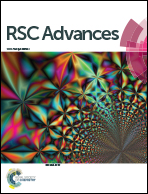Preparation and characterization of Cu–rare earth/Al2O3 catalysts and their application in the electrochemical removal of p-nitrophenol†
Abstract
Cu and rare earth composite catalysts (Cu–rare earth/Al2O3) were prepared on Al2O3 particles using an impregnation method for the electro-catalytic oxidation of p-nitrophenol in this study. The surface topography and crystal structure of the products were characterized using scanning electron microscopy and X-ray diffraction. Results show that the Cu–rare earth/Al2O3 particles have a beneficial effect on p-nitrophenol removal by improving the ˙OH radical generation rate, especially the Cu–Bi/Al2O3 catalyst. The effects of the heat treatment conditions for the Cu–Bi/Al2O3 catalyst on its electro-catalytic activity were investigated. For a temperature of 550 °C and a time of 5 h, the obtained Cu–Bi/Al2O3 catalyst exhibited the highest p-nitrophenol removal, nearly 100% after 60 min electrolysis, and this was decreased by only 4.5% after 10 cycles. In addition, the intermediates formed during degradation were identified using high-performance liquid chromatography, and the major intermediates formed during degradation were benzoquinone, hydroquinone, catechol, p-aminophenol, phenol, maleic acid, succinic acid, and oxalic acid. On the basis of the reaction products identified, a possible degradation pathway for p-nitrophenol was proposed.


 Please wait while we load your content...
Please wait while we load your content...